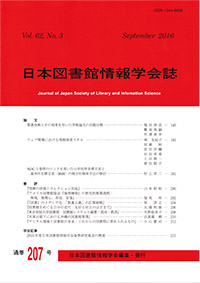All issues

Volume 54 (2008)
- Issue 4 Pages 223-
- Issue 3 Pages 145-
- Issue 2 Pages 71-
- Issue 1 Pages 1-
Predecessor
Volume 54, Issue 3
Displaying 1-4 of 4 articles from this issue
- |<
- <
- 1
- >
- >|
Article
-
Yuko OTAGIRI, Haruki NAGATAArticle type: Article
2008 Volume 54 Issue 3 Pages 145-162
Published: September 30, 2008
Released on J-STAGE: May 04, 2017
JOURNAL OPEN ACCESSIn this paper, we examine the relevance judgment process of information retrieval; the way how users compose the mental representation of the retrieved text of database records and comprehend it; correspondence between the text and user's mental representation; the involvement of user's information needs in the process. This study was conducted through an empirical experiment of relevance judgment. The participants are 4 graduate students and 3 undergraduate students whose major are Library information science and Veterinary science. The "relevance elements" (relevant phrases) had been extracted by think-aloud protocols during their relevance judgment process, and those were analyzed from text comprehension viewpoints. At the result we found that users compose the mental representation which does not stand as the retrieved text and they often decide relevance by it. And, the information needs and the inference influenced it.View full abstractDownload PDF (1841K) -
Kumiko NOGUCHIArticle type: Article
2008 Volume 54 Issue 3 Pages 163-187
Published: September 30, 2008
Released on J-STAGE: May 04, 2017
JOURNAL OPEN ACCESSChildren's reading activities become active today. Above all, school education plays a great role in children's reading activities. Reading guidance has always been performed as part of school education. Therefore, it is important that our future reading guidance is planned on the basis of the history of its past. This study examined Namekawa Michio's reading guidance theory, which led reading guidance after World War II. The purpose of the study was to clarify the characteristics of Namekawa's theory and to consider its significance and limitations. Two results were revealed. First, there were two elements -"life guidance about reading" and "life guidance by reading"- in Namekawa's theory. Second, there is a thought to gradually attach importance to "life guidance by reading" as well as "life guidance about reading". The significance of Namekawa's theory is that it showed the importance of reading guidance in bringing out the sentiment and intellect of a child. However, Namekawa's theory was limited by the fact that it was confined to an ideal of reading guidance.View full abstractDownload PDF (3218K) -
Fukuji IMAIArticle type: Article
2008 Volume 54 Issue 3 Pages 188-203
Published: September 30, 2008
Released on J-STAGE: May 04, 2017
JOURNAL OPEN ACCESSDuring the occupation period of WWII (World War II) in Japan, a reform of school education was conducted by the General Headquarters of the Supreme Commander for the Allied Powers (GHQ/SCAP) and the Ministry of Education in Japan. In the process of the reformation, "the new education movement after WWII" emerged from school teachers. "Core Curriculum Movement" is one of the education movements by some of the teachers. This study examined how the practice of the movement took up the education of material use in 1945-1953, for exploring the needs of school library at that time in Japan. Especially, this study focused on "the plan of Akashi elementary school attached to Hyogo normal school for woman". The study found two points of the the material use for learning. First, The method of the plan was based on the Virginia elementary school program using large varieties of material. Second, in the process of learning activities of the plan, the teachers of the school conducted the student getting the material use skill and using library. Therefore, the teachers brought in the American education of material use to the plan, and was partly assumed the education using school library. Furthermore, this study suggested that the material use education was assumed on the other plans in the movement.View full abstractDownload PDF (1867K) -
Yuriko NAKAMURAArticle type: Article
2008 Volume 54 Issue 3 Pages 204-221
Published: September 30, 2008
Released on J-STAGE: May 04, 2017
JOURNAL OPEN ACCESSIn this study, the author examines how Michio Namekawa's philosophy on "reading guidance (DOKUSHO SHIDO)" developed, leading to a clearer understanding of the progression and change of its definition from pre- to post-WWII periods. Namekawa is recognized as one of the key persons to cultivate the practice and philosophy of "reading guidance" in post-war Japan. To conduct the research, the author produces a chronology of Namekawa's writings until 1950. The research then shows both continuity and discontinuity of the time between pre- and post-WWII. The outset of Namekawa's philosophical development, which blossoms in the post-war period, can be determined in the book which he co-authored, JIDO BUNKA RON, published in 1941. While the children's cultural improvement movement was transpiring in the late 1930s, his interest concerning reading guidance deepened. Under the occupation after the war, the CIE Education Division led Namekawa to shape his philosophy and curriculum more concretely. Around 1949, he found important components of the concept of "integrating reading guidance into a student's personal life-Guidance" which Namekawa maintained throughout the post-war period.View full abstractDownload PDF (2065K)
- |<
- <
- 1
- >
- >|